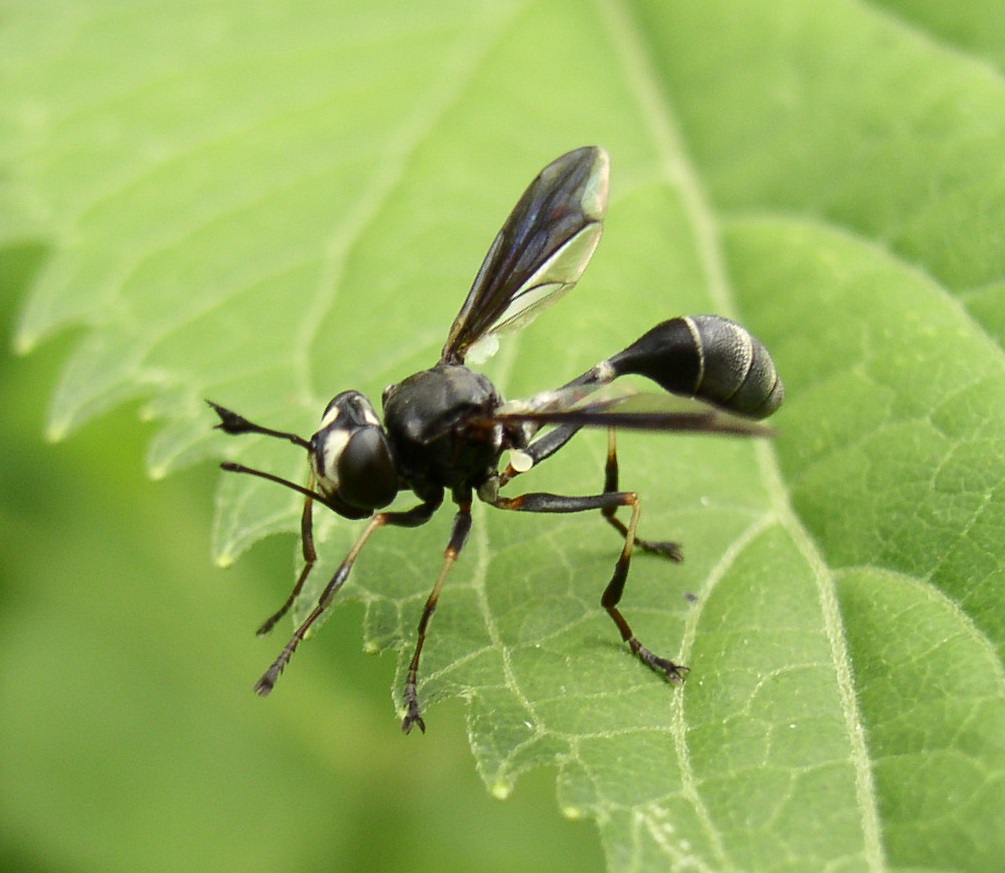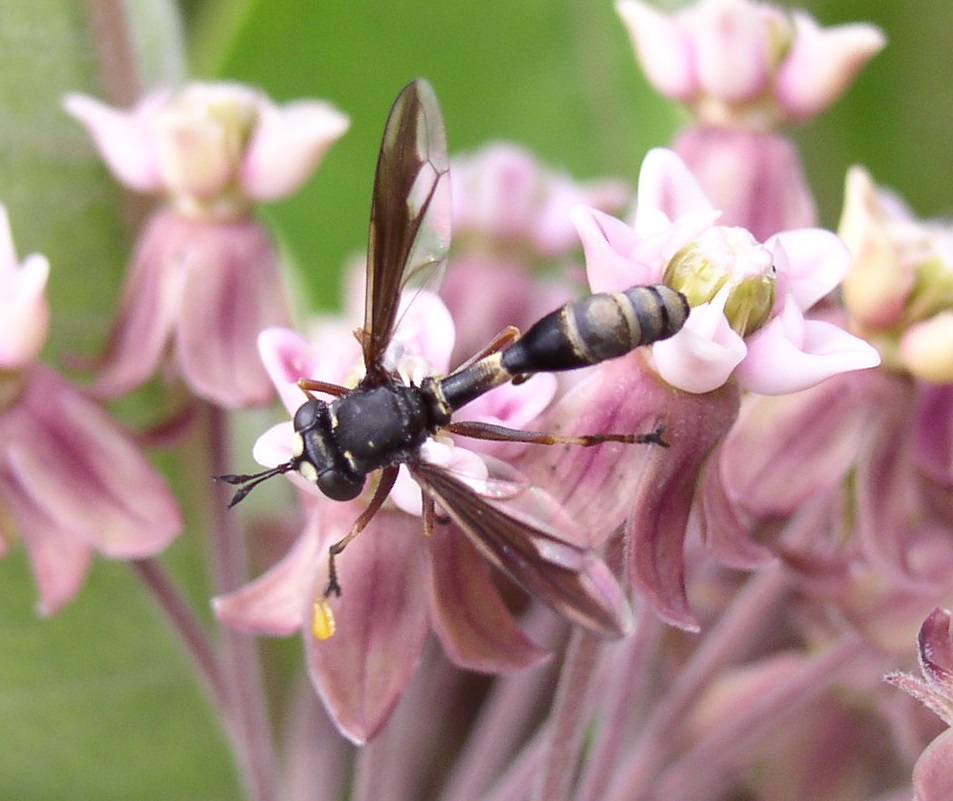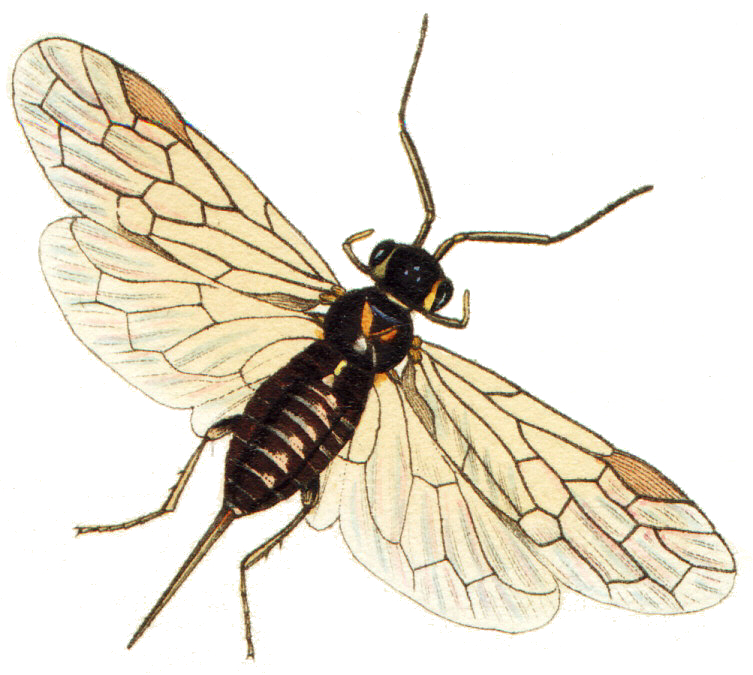|
Conopoidea
The Conopidae, usually known as the thick-headed flies, are a family of flies within the Brachycera suborder of Diptera, and the sole member of the superfamily Conopoidea. Flies of the family Conopidae are distributed worldwide in all the biogeographic realms except for the poles and many of the Pacific islands. About 800 species in 47 genera are described worldwide, about 70 of which are found in North America. The majority of conopids are black and yellow, or black and white, and often strikingly resemble wasps, bees, or flies of the family Syrphidae, themselves notable bee mimics. A conopid is most frequently found at flowers, feeding on nectar with its proboscis, which is often long. Description For terms see Morphology of Diptera. Rather thinly pilose or nearly bare, elongate or stout flies of small to large size (3–20 mm, usually 5–15 mm). They are often lustrous with a black and yellow colour pattern or with reddish brown markings. The head is broad an ... [...More Info...] [...Related Items...] OR: [Wikipedia] [Google] [Baidu] |
Physoconops
''Physoconops'' is a genus of thick-headed flies in the family Conopidae. There are about 13 described species in ''Physoconops''. Species * ''Physoconops analis ''Physoconops analis'' is a species of thick-headed fly The Conopidae, usually known as the thick-headed flies, are a family of flies within the Brachycera suborder of Diptera, and the sole member of the superfamily Conopoidea. Flies of the ...'' (Fabricius, 1805) * '' Physoconops brachyrhynchus'' (Macquart, 1843) * '' Physoconops bulbirostris'' (Loew, 1853) * '' Physoconops discalis'' (Williston, 1892) * '' Physoconops excisus'' (Wiedemann, 1830) * '' Physoconops floridanus'' Camras, 1955 (Florida physoconops) * '' Physoconops fronto'' (Williston, 1885) * '' Physoconops gracilis'' (Williston, 1885) * '' Physoconops nigrimanus'' (Bigot, 1887) * '' Physoconops obscuripennis'' (Williston, 1882) * '' Physoconops sylvosus'' (Williston, 1882) * '' Physoconops townsendi'' Camras, 1955 * '' Physoconops weemsi'' Camras, ... [...More Info...] [...Related Items...] OR: [Wikipedia] [Google] [Baidu] |
Physocephala
''Physocephala'' is a genus of flies from the family Conopidae. Species *'' P. antiqua'' (Wiedemann, 1830) *'' P. biguttata'' von Röder, 1883 *'' P. burgessi'' (Williston, 1882) *'' P. chrysorrhoea'' ( Meigen, 1824) *'' P. curticornis'' Kröber, 1915 *'' P. floridana'' Camras, 1957 *'' P. furcillata'' (Williston, 1882) *'' P. lacera'' ( Meigen, 1824) *'' P. laeta'' Becker, 1913 *'' P. laticincta'' (Brullé, 1832) *'' P. marginata'' ( Say, 1823) *'' P. nervosa'' Krober, 1915 *'' P. nigra'' (De Geer, 1776) *'' P. pusilla'' ( Meigen, 1824) *'' P. rufipes'' (Fabricius, 1781) *'' P. sagittaria'' ( Say, 1823) *'' P. texana'' (Williston, 1882) *''P. tibialis'' ( Say, 1829) *'' P. truncata'' ( Loew, 1847) *'' P. vaginalis'' ( Rondani, 1865) *'' P. variegata'' ( Meigen, 1824) *'' P. vittata'' (Fabricius Fabricius ( la, smith, german: Schmied, Schmidt) is a surname. Notable people with the surname include: *people from the Ancient Roman gens Fabricia: **Gaius Fabricius Luscinus, th ... [...More Info...] [...Related Items...] OR: [Wikipedia] [Google] [Baidu] |
Dalmannia
''Dalmannia'' is a genus of flies from the family Conopidae. Species *'' Dalmannia aculeata'' ( Linnaeus, 1758, 1761) *'' Dalmannia blaisdelli'' Cresson, 1919 *'' Dalmannia confusa'' Becker, 1923 *'' Dalmannia dorsalis'' (Fabricius, 1794) *'' Dalmannia heterotricha'' Bohart, 1938 *'' Dalmannia marginata'' ( Meigen, 1824) *'' Dalmannia nigriceps'' Loew, 1866 *'' Dalmannia pacifica'' Banks, 1916 *'' Dalmannia picta'' Williston, 1883 *'' Dalmannia punctata'' (Fabricius, 1794) *'' Dalmannia vitiosa'' Coquillett Daniel William Coquillett (23 January 1856, Pleasant Valley, Ill. – 7 July 1911 Atlantic City, New Jersey) was an American entomologist who specialised in Diptera. He wrote a revision of the dipterous family Therevidae and many other scientifi ..., 1892 References Conopidae Conopoidea genera {{Conopoidea-stub ... [...More Info...] [...Related Items...] OR: [Wikipedia] [Google] [Baidu] |
Physocephala Tibialis Male
''Physocephala'' is a genus of flies from the family Conopidae. Species *'' P. antiqua'' (Wiedemann, 1830) *'' P. biguttata'' von Röder, 1883 *'' P. burgessi'' (Williston, 1882) *'' P. chrysorrhoea'' ( Meigen, 1824) *'' P. curticornis'' Kröber, 1915 *'' P. floridana'' Camras, 1957 *'' P. furcillata'' (Williston, 1882) *'' P. lacera'' ( Meigen, 1824) *'' P. laeta'' Becker, 1913 *'' P. laticincta'' (Brullé, 1832) *'' P. marginata'' ( Say, 1823) *'' P. nervosa'' Krober, 1915 *'' P. nigra'' (De Geer, 1776) *'' P. pusilla'' ( Meigen, 1824) *'' P. rufipes'' (Fabricius, 1781) *'' P. sagittaria'' ( Say, 1823) *'' P. texana'' (Williston, 1882) *''P. tibialis'' ( Say, 1829) *'' P. truncata'' ( Loew, 1847) *'' P. vaginalis'' ( Rondani, 1865) *'' P. variegata'' ( Meigen, 1824) *'' P. vittata'' (Fabricius Fabricius ( la, smith, german: Schmied, Schmidt) is a surname. Notable people with the surname include: *people from the Ancient Roman gens Fabricia: **Gaius Fabricius Luscinus, th ... [...More Info...] [...Related Items...] OR: [Wikipedia] [Google] [Baidu] |
Thecophora
''Thecophora'' is a genus of thick-headed fly from the family Conopidae. They are frequently found on flowers. They are endoparasites of other insects, specially bees. Species These 42 species belong to the genus ''Thecophora'': * ''Thecophora abbreviata'' (Loew, 1866) * ''Thecophora africana'' (Brunetti, 1925) * ''Thecophora apivora'' Zimina, 1968 * ''Thecophora atra'' (Fabricius, 1775) * ''Thecophora australiana'' (Camras, 1955) * ''Thecophora bimaculata'' Preyssler, 1791 * ''Thecophora caenovala'' (Krober, 1916) * ''Thecophora caevovalva'' (Krober, 1915) * ''Thecophora cinerascens'' Meigen, 1804 * ''Thecophora clementsi'' * ''Thecophora curticornis'' (Krober, 1916) * ''Thecophora distincta'' (Wiedemann in Meigen, 1824) * ''Thecophora flavicornis'' (Krober, 1936) * ''Thecophora flavipes'' (Brunetti, 1923) * ''Thecophora freidbergi'' * ''Thecophora fulvipes'' Robineau-Desvoidy, 1830 * ''Thecophora haitiensis'' (Parsons, 1940) * '' Thecophora hyalipennis'' (Krober, 1916) * ... [...More Info...] [...Related Items...] OR: [Wikipedia] [Google] [Baidu] |
Myopa
''Myopa'' is a genus of flies from the family Conopidae. They are parasitic on honey bees ''Apis mellifera'', also ''Andrena'', and mustache bees ''Anthophora''. Species *'' M. bohartorum'' Camras, 1953 *'' M. buccata'' (Linnaeus, 1758) *'' M. castanea'' (Bigot, 1887) *'' M. clausa'' Loew, 1866 *'' M. curticornis'' Kröber, 1916 *'' M. curtirostris'' Kröber, 1916 *'' M. dorsalis'' Fabricius, 1794 *'' M. extricata'' Collin, 1960 *'' M. fasciata'' Meigen, 1804 *'' M. fenestrata'' Coquillett, 1902 *'' M. flavopilosa'' Kröber, 1916 *'' M. longipilis'' Banks, 1916 *'' M. melanderi'' Banks, 1916 *'' M. metallica'' Camra, 1992 *'' M. minor'' Strobl, 1906 *'' M. mixta'' Frey, 1958 *'' M. morio'' Meigen, 1804 *'' M. occulta'' Wiedemann in Meigen, 1824 *'' M. perplexa'' Camras, 1953 *'' M. picta'' Panzer, 1798 *'' M. plebeia'' Williston, 1885 *'' M. polystigma'' Rondani, 1857 *'' M. rubida'' (Bigot, 1887) *'' M. stigma'' Meigen, 1824 *'' M. strandi'' Duda, 1940 *'' M. tessella ... [...More Info...] [...Related Items...] OR: [Wikipedia] [Google] [Baidu] |
Stylogaster
The conopid genus ''Stylogaster'' is a group of unusual flies. It is the only genus in the subfamily Stylogastrinae, which some authorities have historically treated as a separate family Stylogastridae (or Stylogasteridae). Biology Stylogastrines are obligate associates of Cockroaches, Orthoptera, some Diptera and ants.Couri, M.S., Pont, A.C. & Kirk-Spriggs, A.H. 2013. New Muscidae (Diptera) hosts of ''Stylogaster'' Macquart (Diptera: Conopidae) from the Afrotropical Region. ''African Invertebrates'' 54 (2): 401–40/ref> These flies typically use army ants' raiding columns to flush out their prey, ground-dwelling Orthoptera and/or roaches. Stylogastrines are somewhat atypical for conopids, in that the egg itself is shaped somewhat like a harpoon, with a rigid barbed tip, and the egg is forcibly jabbed into the host. The female of some species waits for army ants to flush out a target, then she dives in and jabs an egg into the host. The ''Stylogaster'' larvae then develop ... [...More Info...] [...Related Items...] OR: [Wikipedia] [Google] [Baidu] |
Myopinae
Myopinae is a subfamily of flies from the family Conopidae The Conopidae, usually known as the thick-headed flies, are a family of flies within the Brachycera suborder of Diptera, and the sole member of the superfamily Conopoidea. Flies of the family Conopidae are distributed worldwide in all the bi .... Tribes * Myopini * Sicini * Zodionini References Bugguide.net. Subfamily Myopinae Conopidae Brachycera subfamilies {{Conopoidea-stub ... [...More Info...] [...Related Items...] OR: [Wikipedia] [Google] [Baidu] |
Stylogastrinae
The conopid genus ''Stylogaster'' is a group of unusual flies. It is the only genus in the subfamily Stylogastrinae, which some authorities have historically treated as a separate family Stylogastridae (or Stylogasteridae). Biology Stylogastrines are obligate associates of Cockroaches, Orthoptera, some Diptera and ants.Couri, M.S., Pont, A.C. & Kirk-Spriggs, A.H. 2013. New Muscidae (Diptera) hosts of ''Stylogaster'' Macquart (Diptera: Conopidae) from the Afrotropical Region. ''African Invertebrates'' 54 (2): 401–40/ref> These flies typically use army ants' raiding columns to flush out their prey, ground-dwelling Orthoptera and/or roaches. Stylogastrines are somewhat atypical for conopids, in that the egg itself is shaped somewhat like a harpoon, with a rigid barbed tip, and the egg is forcibly jabbed into the host. The female of some species waits for army ants to flush out a target, then she dives in and jabs an egg into the host. The ''Stylogaster'' larvae then develop a ... [...More Info...] [...Related Items...] OR: [Wikipedia] [Google] [Baidu] |
Conopinae
Conopinae is a subfamily of flies from the family Conopidae. Tribes *Tribe Conopini ** Genus ''Conops'' Linnaeus, 1758 ** Genus ''Leopoldius'' Rondani, 1843 *Tribe Physocephalini Physocephalini is a tribe of fly from the family Conopidae. Genera *Genus ''Physocephala'' Schiner, 1861 * Genus ''Physoconops ''Physoconops'' is a genus of thick-headed flies in the family Conopidae The Conopidae, usually known as t ... ** Genus '' Physocephala'' Schiner, 1861 ** Genus '' Physoconops'' Szilady, 1926 References Conopidae Brachycera subfamilies {{Conopoidea-stub ... [...More Info...] [...Related Items...] OR: [Wikipedia] [Google] [Baidu] |
Aculeata
Aculeata is a subclade of Hymenoptera containing ants, bees, and stinging wasps. The name is a reference to the defining feature of the group, which is the modification of the ovipositor into a stinger. However, many members of the group cannot sting, either retaining the ovipositor, or having lost it altogether. A large part of the clade is parasitic. This group includes all of the eusocial Hymenopterans. It is theorized that the possession of a venomous sting was important in the repeated evolution of eusociality within Hymenoptera. The oldest aculeates are known from the Late Jurassic Karabastau Formation of Kazakhstan, represented by the family Bethylonymidae, which may be para or polyphyletic. Classification The use of the name Aculeata has a long history at the rank of infraorder or division. The Aculeata are a monophyletic, or good natural group, containing all the descendants of a single common ancestor. The Aculeata are therefore maintained as a taxon In bio ... [...More Info...] [...Related Items...] OR: [Wikipedia] [Google] [Baidu] |
Endoparasitoid
In evolutionary ecology, a parasitoid is an organism that lives in close association with its host at the host's expense, eventually resulting in the death of the host. Parasitoidism is one of six major evolutionary strategies within parasitism, distinguished by the fatal prognosis for the host, which makes the strategy close to predation. Among parasitoids, strategies range from living inside the host (''endoparasitism''), allowing it to continue growing before emerging as an adult, to paralysing the host and living outside it (''ectoparasitism''). Hosts can include other parasitoids, resulting in hyperparasitism; in the case of oak galls, up to five levels of parasitism are possible. Some parasitoids influence their host's behaviour in ways that favour the propagation of the parasitoid. Parasitoids are found in a variety of taxa across the insect superorder Endopterygota, whose complete metamorphosis may have pre-adapted them for a split lifestyle, with parasitoid larv ... [...More Info...] [...Related Items...] OR: [Wikipedia] [Google] [Baidu] |






